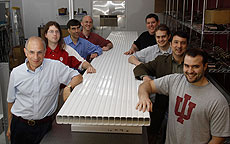Indiana University

Some of the team of IU scientists and technical staff working on a $278
million U.S. Department of Energy neutrino project are, clockwise from left,
Stuart Mufson, Luke Corwin, Jon Urheim, Jonathan Paley, Fritz Busch, Bob
Armstrong, Mark Messier and Brian Baptista. They are standing beside a
prototype component of the liquid scintillator that will be used to collect
light from subatomic particle interactions. Photo: Indiana University Office
of Communications.
NAME:
Indiana University, Bloomington
HOME TOWN:
Bloomington, IN
MASCOT:
Hoosiers
SCHOOL COLORS:
Cream and crimson
PARTICLE PHYSICS COLLABORATIONS:
ATLAS, DZero, Fermilab Lattice Group, HEAT, HotQCD, ILC, JDEM/IDECS, MILC, MiniBooNE, MINOS, MIPP, NOvA, SciBooNE
EXPERIMENTS AT FERMILAB:
DZero, ILC, JDEM/IDECS, MiniBooNE, MINOS, MIPP, NOvA
SCIENTISTS AND STUDENTS AT FERMILAB:
13 faculty, 14 scientists/post-docs and 13 students
COLLABORATING AT FERMILAB SINCE:
1972
MAJOR CONTRIBUTIONS:
Muon and central tracking detectors for DZero Run 1 and 2 and leadership
of heavy flavor analysis. Lattice QCD studies of spectrum, heavy-light hadrons and high-temperature QCD. On-board calibration for JDEM/ IDECS. MiniBooNE DAQ and charged and neutral-current elastic scattering analyses. Reconstruction, calibration and analysis of MINOS and MIPP. Development of the NOvA proposal and its scintillator and electronics systems. Theory and phenomenology of CPT-violating and other extensions to the Standard Model.
RESEARCH FOCUS:
Heavy flavors, electroweak interactions, QCD, neutrinos, dark energy, cosmic rays, Standard Model extensions.
WHAT SETS PARTICLE PHYSICS AT INDIANA UNIVERSITY APART?
Ours is one of the strongest neutrino groups in the U.S. and we have strengths on all frontiers: energy, intensity, and cosmic. We are a unique collaboration between physics and astronomy, experiment and theory.
FUNDING AGENCY:
Department of Energy and National Science Foundation
FAVORITE NATIONAL LABORATORY:
Fermilab
View all University profiles
|